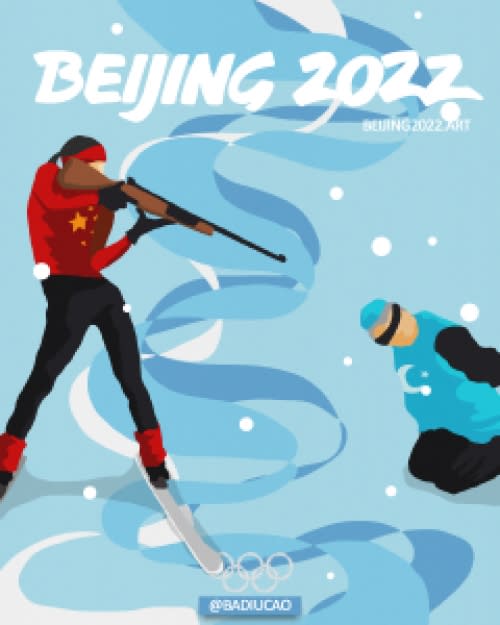Chinese Artist Calls GW University President ‘So Ignorant’ for Censoring Anti-CCP Art: ‘Huge Scandal and a Shame’

Chinese political cartoonist and activist Badiucao called it a “huge scandal and a shame” that George Washington University’s president is “so ignorant” that he could be “personally offended” by the artist’s cartoons portraying Chinese Communist Party atrocities.
Badiucao’s comments came in an interview with National Review on Monday after GWU president Mark S. Wrighton vowed to remove posters of Badiucao’s cartoons that called out China’s human-rights abuses, including the Uyghur genocide and oppression in Tibet and Hong Kong. Before backtracking on Monday, Wrighton said he was “personally offended” by the posters and would work to determine who was responsible for hanging them.

“I think it’s a huge scandal and shame that a president of well known University is so ignorant and not informed to understanding my art,” he said. “We’re not talking about someone who is not aware of the international situation or the human rights issues around the Olympic Games. This is really just public common sense.”
1. In response to CSSA, GeorgeWashington Uni @GWtweets president @PresWrightonGW claims he is “personally offended” by my art criticising China’s rights abuse like Uyghur genocide & oppression in Tibet & HongKong.
I demand him an explanation why exposing CCP’s abuse offends him. pic.twitter.com/Bm5k2nFAJ4
— 巴丢草 Badiucao💉💉 (@badiucao) February 7, 2022
He said his series is not abstract expression that requires a deep understanding, but is meant to be understood after a second of seeing them.
“So it is really, really absurd that an intellectual president of a university is saying he doesn’t know about it, he has no idea of the content and rushed into judgment,” he said. “That is definitely not acceptable.”
Wrighton shifted gears earlier on Monday, saying he had “responded hastily” to student concerns over the art last week after the university received a “number of concerns through official university reporting channels that cited bias and racism against the Chinese community,” and he received an email directly from a student who expressed concerns.
@GWtweets President @PresWrightonGW's full statement: pic.twitter.com/5fs3yR0i5F
— FIRE (@TheFIREorg) February 7, 2022
“At that time, and without more context on the origin or intent of the posters, I responded hastily to the student, writing that I, too, was concerned,” he said. “University staff also responded to ensure the posters were removed. These responses were mistakes. Every member of the GW community should feel welcome and supported, but I should have taken more time to understand the entire situation before commenting.”
He added: “I have since learned from our university’s scholars that the posters were designed by a Chinese-Australian artist, Badiucao, and they are a critique of China’s policies. Upon full understanding, I do not view these posters as racist; they are political statements. There is no university investigation underway, and the university will not take any action against the students who displayed the posters.”
Badiucao said he was not “100 percent satisfied” with the statement and would like a “more sincere apology” from Wrighton, saying he did not see the president express a “shred of regret” throughout the statement. He added that he would also like to see the university support the art and allow it to be prominently displayed on campus to start more conversation about China’s human-rights abuses.
Badiucao was first alerted to the situation by GWU students who told him the Chinese Students and Scholars Associations on campus was carrying out a “manhunt” to find the student activists who posted his art around campus.

Last week the CSSA, a group that is affiliated with the Chinese Communist Party, asked its members to sign a joint letter condemning the art. The group wrote that posters that “insulted China and discriminated against Asians appeared in many teaching buildings the GW campus.”
“This series of posters has serious racist views, and to a large extent, has carried out extremely vicious personal attacks on all international students from China and Asian groups,” the group added, according to correspondence obtained by Badiucao.
“When I learned this news, I felt really sorry for those kids who are doing their activism to spread the true story of the Chinese government’s crime on their campus in order to make people . . . talk about those very important issues during the Winter Olympic time,” he said.
He added it was even “more disappointing and actually shocking” when the president of GWU replied to the groups by saying he too felt deeply personally offended by the art. He called Wrighton’s actions “definitely not acceptable,” as he expected one of the top universities in the U.S. to defend human rights and students’ freedom of speech on campus and to be able to tell the difference between targeting of the Chinese government and discrimination against Chinese people.
Badiucao noted that the “witch hunt” was prompted by the school’s CSSA.
In 2018, Foreign Policy reported that the Chinese Embassy paid students from CSSAs at Washington, D.C., universities to line the streets to welcome Chinese President Xi Jinping when he visited in September 2015. A Chinese student at George Washington University told the outlet that participants received $20 each for their effort, which was distributed through the CSSA months later.
Foreign Policy reported at the time that the Chinese government maintains close relationships with the Chinese student groups across the U.S. The report noted that as Xi “has strengthened the party’s control over every aspect of Chinese society and sought to extend his power abroad, consular officials have markedly increased their efforts to exert ideological influence over students — leaving some CSSA members wary to speak out against what they see as unwanted government intrusion.”
Badiucao, who has been in self-imposed exile in Australia since 2009, said it is not a new experience for him to have the CCP attempt to exert influence to censor his art.
He recalled an incident earlier this year when the Chinese Embassy in Rome attempted to stop his work from being displayed at a museum in Brescia, Italy. The embassy wrote a letter to the city’s mayor saying the art was “full of anti-Chinese lies” and that the images “distort the facts, spread false information, mislead the understanding of the Italian people and seriously injure the feelings of the Chinese people.”
Still, Badiucao says he feels it is his responsibility as an artist to speak out against the CCP.
“I am China-born,” he said. “I lived in China for more than 20 years. I love this land. I care about the people who are living there. It is really hard witnessing my people suffering from this regime, decades after decades.”
“I have to speak up on those issues, because people inside of China would have tremendous difficulty to talk about those issues without the threats and harassment they’re facing, but I’m outside of China in a relatively safe and free place,” he said.
As the Olympics are underway and some American corporations and citizens have willingly turned away from China’s abuses, Badiucao called on Americans who may be supporting Black Lives Matter or Stop Asian Hate to hold the same standard to calling out China’s racist genocide against the Uyghurs.
“I hope in the future people in America [won’t shy] away from [criticizing] the Chinese government’s crimes against humanity and human rights and [will] be able to tell what is racist and what is not, instead of just remaining silent because they are afraid of being called racist.”

